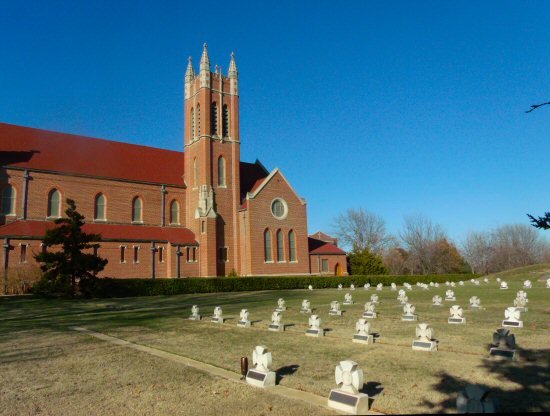
How did this Okie Traditionalist Catholic Movement start?
Well, going back to the Early Church, priests offering Mass in the Roman rite offered it in the sacred Latin language, with sacred Gregorian chant, facing the altar "ad orientem" i.e. "to the East" in a posture of "sacrifice to the Father." The Roman liturgy revised under different popes had a common traditional form. Spanish missionaries passing through what is today Oklahoma offered this traditional Mass. The original Catholic missionaries to establish the Church in Oklahoma, the Benedictine monks of St. Gregory's Abbey, brought this liturgical tradition as well.

But in 1970 the Roman missal eliminated the main traditions as norms for Sunday Mass. Immediately Mass was offered in a manner that as a matter-of-fact closely resembled Protestant liturgies.

But don't Roman rite Catholics have a right to their liturgical tradition???
A few remnants of traditional Catholics sprang up in 1970. In OKC, they were aided by a wealthy benefactor who built a traditional chapel, St. Michael's in the suburb of Bethany, OK. The traditional Catholic Mass/Faith was not tolerated by the diocese, so the faithful invited in priests of the Society of St. Pius X, as well as different other priests who had decided to remain faithful to the Mass of their ordination. As a matter of convenience, St. Michael's Chapel in OKC came to be served by priests of the Fraternity of St. Peter for a while, which would eventually leave to build their own church. Now in OKC, one may legitimately attend the Traditional Latin Mass offered either with the Society or Fraternity.

A similar path was taken in Tulsa, starting in 1970. A group huddled around the private, side altar Sunday Latin Mass of an aging Augustinian monk at Cascia Hall Preparatory School chapel until he stopped this service. The group started a chapel in a garage until it outgrew the space. Mass would be held in rented hotel banquet rooms, until a proper church was built--St. John Fisher Catholic Church--and blessed by His Excellency Archbishop Marcel Lefebvre in the early 80's. After a decade, the group again outgrew its space, swopping the small church with a Protestant group for their larger church, where Mass is currently offered west of downtown.
In the meantime, the Fraternity of St. Peter established an apostolate at an experimental "quasi-parish" in a run-down neighborhood of north Tulsa. The community was called The Parish of St. Peter. Traditionalist Catholics were isolated on their own island, paying rent to have Mass at a north-side church, until they finally acquired their own countryside church on the West-side of Tulsa, with an official parish called Most Precious Blood.
Recently His Excellency Bishop Slattery of Tulsa retired. He is considered by many to be a very tradition-minded bishop, for establishing Clear Creek Abbey, the Fraternity in Tulsa, and the new exorcist Society.

If you are in OKC, I encourage readers to experience a Traditional Latin Mass with the Society or Fraternity; or if you are in the eastern part of the state, at the Society, Fraternity, or St. Peter and Paul in Tulsa, or at Clear Creek monastery.